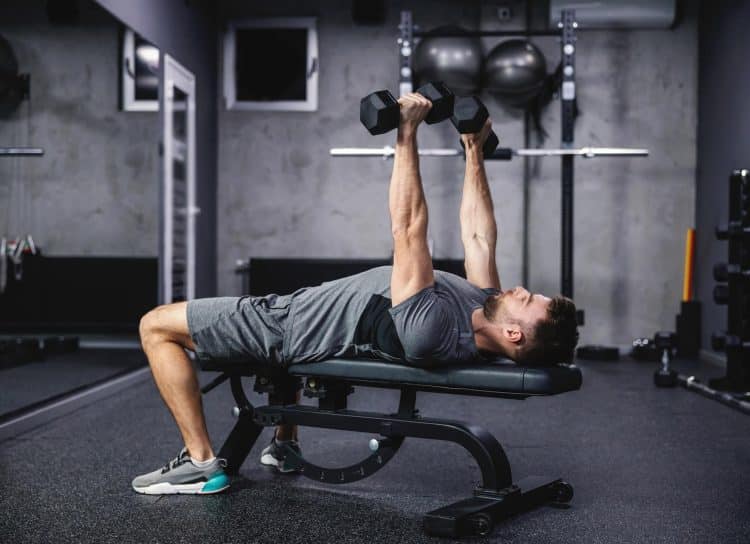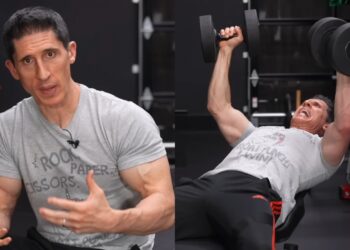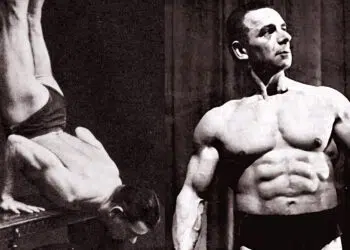Building muscle, losing weight, and getting fit can often seem time-consuming. After all, according to many fitness experts, getting and staying in shape requires a strict diet and intensive-time consuming workouts.
While such an all-consuming approach to diet and exercise might be necessary if you plan on being a bodybuilder or Olympic athlete, the average person probably doesn’t need to take fitness so seriously.
In fact, as a 30-plus-year veteran personal trainer, I believe that trying to do much is the reason that so many fitness journeys end shortly after they begin.
You see, most people don’t have the time or energy to maintain an exhaustive workout program or ultra-strict diet. Sooner rather than later they discover the “juice isn’t worth the squeeze,” and there are other things they’d rather be doing during their leisure time.
Research supports my opinion, and studies suggest that lack of time, energy, facilities, and motivation are all legitimate barriers to exercise (1).
The good news is that it doesn’t have to be hell to be healthy, and most people can get into good shape without becoming slaves to their diet or exercise program.
Level Up Your Fitness: Join our 💪 strong community in Fitness Volt Newsletter. Get daily inspiration, expert-backed workouts, nutrition tips, the latest in strength sports, and the support you need to reach your goals. Subscribe for free!
In this article, I reveal how to get fit and lose weight with time and less effort.
Consistency – The Key to Your Success!
There are lots of methods for building muscle, getting fit, and burning fat. And while some may be slightly better than others, the differences between them are usually statistically irrelevant.
For example, you can burn fat and lose weight with low-intensity steady-state cardio, or you can up the pace and do high-intensity intervals. While very different, both types of exercise can help you get fitter and leaner.
The same is true for strength training – you can lift dumbbells or barbells, use resistance machines, or do bodyweight exercises. Regardless of what you do, your body will adapt, and your muscles will get bigger and stronger.
Instead, what really matters is workout consistency.
Missed workouts, no matter how well-designed, don’t work. Consequently, the less-than-ideal workout you do regularly will always produce better results than a perfect workout performed infrequently.
In short, any exercise is better than no exercise, and the “best” workout is the one you’re prepared and able to do regularly. With that in mind, most people should forget long, daily workouts and unpleasant diets, both of which are usually unsustainable.
Instead, choose shorter, less complex programs that you can do day in and day out without missing workouts. While some may think of this as lazy, I prefer to call it smart.
So, if you are fed up with workouts that are too long and impractical to do consistently, maybe it’s time to try a different approach. All you need is 15-20 minutes a day and exercises you can do at home.
Related: Calisthenics vs. Weightlifting: Which Is Best?
The Lazy Person’s Workout Program Overview
Don’t let the name of this training plan fool you – you’ll still need to put in some effort to get results. However, the workouts are short and simple, making them ideal for anyone who has struggled with workout consistency in the past.
While naysayers may scoff at how short these workouts are, it’s important to remember that even a few minutes of exercise will produce notable increases in fitness and strength. So, while more exercise will undoubtedly produce better results, that’s of no consequence if you are unable to work out for longer or more often.
Plus, months of consistent training add up, leading to noticeable improvements in fitness and health. In contrast, a program you do once and never repeat is all but pointless.
Warming Up for a Great Workout
Even short workouts need a warm-up. Not warming up will make your training less effective and could result in injury. So, put an extra five minutes aside for your warm-up. Begin with three minutes of light cardio, e.g., jogging, jump rope, jumping jacks, etc., followed by dynamic mobility and flexibility exercises for your major joints and muscles.
Warmed up and ready to go? Then let’s get to work!
Program Overview
This program comprises three workouts which you perform in rotation. It’s up to you how many workouts you do each week, but the more often you train, the better your results will be. As a minimum, you should work out three times a week, but no more than six times.
For example:
- Monday – workout 1
- Wednesday – workout 2
- Friday – workout 3
Or:
- Monday – workout 1
- Tuesday – workout 2
- Thursday – workout 3
- Friday – workout 1
Or:
- Monday – workout 1
- Tuesday – workout 2
- Wednesday – workout 3
- Thursday – workout 1
- Friday – workout 2
Or:
Level Up Your Fitness: Join our 💪 strong community in Fitness Volt Newsletter. Get daily inspiration, expert-backed workouts, nutrition tips, the latest in strength sports, and the support you need to reach your goals. Subscribe for free!
- Monday – workout 1
- Tuesday – workout 2
- Wednesday – workout 3
- Thursday – workout 1
- Friday – workout 2
- Saturday – workout 3
Of course, you don’t have to do the same number of workouts each week. Feel free to do three one week and five the next if that’s what your schedule allows. However, avoid doing less than three workouts per week, as such low frequency will impede your progress.
Workout One – Calisthenic Strength Training
Calisthenics or bodyweight training is arguably the best lazy person’s strength workout. Requiring no gym equipment and minimal space, you can do calisthenics almost anywhere and anytime. As such, you won’t have to waste your valuable time commuting to or from the gym, making it much easier to work out consistently.
This workout comprises three exercises which, between them, work every major muscle in your body. However, for so little exercise volume to produce results, you’ll need to push your sets to within a couple of reps of failure (2).
Do three rounds of the following:
| # | Exercise | Sets | Reps | Rest |
| 1 | Push-up | 3 | AMRAP* | 60 seconds |
| 2 | Pull-up | 3 | AMRAP* | 60 seconds |
| 3 | Tempo squat | 3 | AMRAP* | 60 seconds |
*AMRAP = As Many Reps as Possible
So, do as many reps as you can of exercise #1, rest for one minute, and then do as many reps as possible of exercise #2. Rest another minute and rep out on exercise #3. Rest one more minute and then repeat the sequence twice more.
Don’t worry if your rep count decreases round by round – that’s perfectly normal, and just a sign that you are working hard.
Exercise Instructions
1. Push-up
Target muscles: Pectoralis major, deltoids, triceps, core.
- Squat down and place your hands on the floor, palms flat and roughly shoulder-width apart.
- Walk your feet out and back so your body is straight.
- Brace your core and pull your shoulders back and down.
- Bend your arms and lower your chest to within an inch of the floor.
- Extend your arms and repeat.
Tips:
- Bend your legs and rest on your knees to make this exercise easier.
- Place your feet on a chair or step to make this exercise harder.
- Do not let your hips drop out of alignment, as doing so puts a lot of unwanted stress on your lower back.
2. Pull-up
Target muscles: Latissimus dorsi, biceps, trapezius, deltoids, forearms, core.
- Hang from an overhead bar with an overhand, slightly wider than shoulder-width grip.
- Pull your shoulders back and down and brace your core.
- Bend your legs so your feet are clear of the floor.
- Bend your arms and pull your chin up to the bar.
- Lower back down and repeat.
Tips:
- You can also do this exercise with an underhand grip, which is called chin-ups.
- Do not swing or kick with your legs as doing so will make your workout less effective.
- Use a resistance band for assistance if necessary:
3. Tempo air squat
Target muscles: Quadriceps, hamstrings, gluteus maximus, adductors, adductors.
- Stand with your feet shoulder-width apart, toes turned slightly outward.
- Brace your core and clasp your hands together in front of your chest.
- Bend your knees and descend for a slow count of five.
- Pause at the bottom of your squat for another five-count.
- Stand up and then repeat.
Tips:
- Squat as deep as you can without compromising your form.
- Avoid rounding your lower back as doing so increases your risk of back pain and injury.
- Adjust your tempo as needed. A slower speed makes the exercise harder, whereas a faster tempo is easier.
Workout Two – Tabata Intervals
Contrary to popular opinion, you don’t need to spend hours jogging to improve your fitness or burn fat. In contrast, even just a few minutes of exercise can help you achieve your cardiovascular conditioning goals.
Tabata intervals were invented by Japanese sports scientist Izumi Tabata. Comprising eight 20-second work intervals with ten-second rests, this short but sharp training protocol has been shown to improve aerobic and anaerobic fitness while increasing post-exercise metabolic rate for several hours (3).
You can do Tabatas with almost any type of cardio, including rowers, bikes, and treadmills. Home exercisers can head outside and sprint or do jump rope. Regardless of which exercise you choose, start your workout with an appropriate warm-up and then follow this sequence:
- Exercise as hard as possible for 20 seconds
- Rest for ten seconds
- Repeat for eight rounds
Even with a warm-up, this workout should be over and done in less than 15 minutes, making it an attractive alternative to longer workouts for time-pressed exercisers.
Related: Burn Fat and Build Muscle with Our Top 10 Tabata Workouts
Workout Three – Cardio and Abs Circuit
Your final workout combines cardio with abs exercises to deliver a short but intense workout for your heart, lungs, and midsection. Again, I’ve created this workout so you can do it at home without much exercise equipment.
Do two laps of the following circuit, moving as quickly as possible between exercises to keep your heart rate elevated. Rest one minute between rounds – just enough time to grab a drink and catch your breath!
| # | Exercise | Duration |
| 1 | Jump rope | 60 seconds |
| 2 | Plank | 60 seconds |
| 3 | Alternating step-up | 60 seconds |
| 4 | Oblique crunch | 60 seconds |
| 5 | Jumping jack | 60 seconds |
| 6 | Dead bug | 60 seconds |
| 7 | Burpee | 60 seconds |
| 8 | Saxon side bend | 60 seconds |
|
Rest for one minute and repeat |
||
Tips:
- Feel free to decrease the work intervals if you need a less demanding workout.
- Change the exercises if necessary but try to use similar movement patterns.
- Don’t race during the abs exercises. Instead, adopt a controlled tempo to maximize your mind-muscle connection.
Closing Thoughts
Getting in shape doesn’t have to be a full-time job. In fact, combining a sustainable diet with short but consistent workouts will get most people to where they want to be.
While this lazy person’s approach to fitness may not be the quickest way to reach your goals, it’s many times better than a program where you miss more workouts than you complete.
Of course, you’ll still need to put in the effort, as easy workouts are not known for their effectiveness. However, set aside 20-30 minutes 3-6 times a week and keep at it for the next few months and your consistency will pay off.
So, don’t worry if you are too busy for longer workouts – you don’t need ’em! Get in shape the lazy (but consistent) way!
References:
- Herazo-Beltrán Y, Pinillos Y, Vidarte J, Crissien E, Suarez D, García R. Predictors of perceived barriers to physical activity in the general adult population: a cross-sectional study. Braz J Phys Ther. 2017 Jan-Feb;21(1):44-50. doi: 10.1016/j.bjpt.2016.04.003. Epub 2017 Jan 14. PMID: 28442074; PMCID: PMC5537451.
- Peterson MD, Pistilli E, Haff GG, Hoffman EP, Gordon PM. Progression of volume load and muscular adaptation during resistance exercise. Eur J Appl Physiol. 2011 Jun;111(6):1063-71. doi: 10.1007/s00421-010-1735-9. Epub 2010 Nov 27. PMID: 21113614; PMCID: PMC4215195.
- Emberts T, Porcari J, Dobers-Tein S, Steffen J, Foster C. Exercise intensity and energy expenditure of a Tabata workout. J Sports Sci Med. 2013 Sep 1;12(3):612-3. PMID: 24137082; PMCID: PMC3772611.











